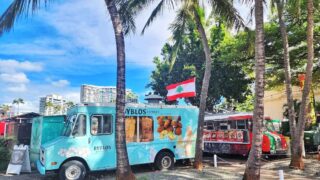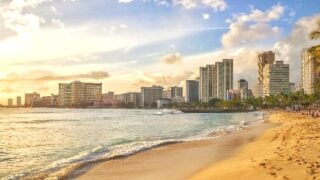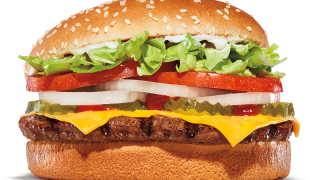Starting January 1, the invisible cost that touches nearly everything in Hawaii jumps about 26%. Visitors will not see it on any receipt, but they will feel it in every meal, every grocery run, and every hotel night on the neighbor islands. It is a shipping rate most travelers never knew existed, and it is about to make Hawaii trips noticeably more expensive in 2026.
Most people imagine Hawaii’s high prices come from the long trip across the Pacific. That part is true. What many visitors never consider is the cost of moving goods between the islands once they arrive. Hawaii has just one regulated inter island carrier for food, lumber, produce, hotel and supplies, and nearly everything that stocks store shelves. When that single lifeline raises its rates there is simply no alternative. Costs move through the system until they reach the last person in line. That person is often a visitor.
What is actually happening.
Effective 1/1/26, Hawaii’s inter-island freight rates rise 25.75% under a new permanent structure approved by regulators. This replaces the temporary 18% increase that expires on December 31, 2025. The new rate becomes the baseline every restaurant, grocery distributor, hotel, contractor, and retail supplier must use when moving goods between islands.
This adjustment follows a previous 46% increase in 2020, which means inter island shipping costs have risen roughly 80% in just the past five years. Even with these increases, the company projects a six million dollar loss in 2026. That reality raises uncomfortable questions about what comes next when the only carrier in a multi-island transportation-dependent state continues losing money despite nearly unprecedented rate jumps.
What this does to visitor facing prices.
A 26% freight increase does not mean retail prices rise by 26%. Shipping is only one part of the final price, and its impact depends on variables including how often and how far an item travels. But it is nonetheless meaningful, especially on the neighbor islands.
The accurate and defensible way to translate this for visitors is by category:
Outer island produce that ships twice, first from the mainland to Oahu and then again to the neighbor islands, typically sees an 8% to 12% retail increase.
Restaurant ingredients and supplies that rely heavily on inter-island movement should see about a 5% to 8% increase.
Hotel goods and linens, which are lower freight weight and often delivered less frequently but in bulk, see a 3% to 5% increase.
Vehicles and heavy equipment, which are extremely freight intensive, see about a 10% to 15% increase.
For visitors, this becomes tangible when they sit down to order. The poke bowl that cost $18 on Kauai is more likely to become closer to $20. The $25 dollar plate lunch approaches $27. It is not catastrophic on a single meal. It becomes noticeable when visitors eat out twice a day for a week. That becomes an extra $50 to $80 in food costs alone, before groceries, hotel expenses, or any other shipped item even enter the picture.
Visitors feel this first because they pay the highest markup points in the entire ecosystem. They are some ways to adjust. Some switch to farmers markets, although even for them there are shipped items. Others try to buy in bulk or change stores. Visitors who buy at retail may be more impacted. As Kauai County Council Chair Mel Rapozo asked when the increase was announced, “How much more can families take?” Residents at least have time to adapt. Visitors arriving for a week discover another incremental price increase in real time.
The neighbor island effect.
Oahu sees little to no relative impact because most goods land there first. The sticker shock grows each time something needs to be forwarded outward. Hawaii Island, including Hilo, sees some of the largest increases because those are further afield and rise more than the statewide average. Kauai remains one of the most freight dependent islands in the chain, which is is in part why visitors there always comment on food and grocery prices. Maui sits in the middle but feels it quickly in restaurant categories and construction related materials used in accommodations.
Smaller islands like Molokai and Lanai have even thinner buffers. When one company controls the freight system and raises rates there is nowhere to shift volume, renegotiate terms, or shop alternatives. Prices simply adjust overnight. Visitors may not know why a sandwich or simple lunch seems more expensive one year compared to the last. This new shipping rate is part of the reason why.
The cumulative cost wave building for 2026.
This new freight increase arrives at the same time visitors are seeing rising dining costs, ongoing upward hotel rate adjustments, new taxes including the Green Fee, and unpredictable airfare patterns. All year we have heard from readers who feel Hawaii is becoming too expensive in ways that no longer match the on-island experience.
Shipping is the quietest of those cost drivers but also one of the most powerful. It touches every other part of cost structures. When containers become more expensive, restaurants update menu prices immediately. Hotels adjust fee structures too. And grocery delivery costs rise as do construction materials. Every visitor facing category depends on that same impacted supply chain.
The timing matters because businesses will spend early 2026 recalculating costs and renegotiating contracts. Prices may not all change overnight but instead may adjust in waves. By spring and summer, visitors booking trips should have already noticed higher meal costs on Maui, higher grocery bills on Kauai, and upward pressure on hotel charges that quietly account for the new freight fee reality.
Why this matters more than a single rate change.
A 46% increase in 2020 followed by a 25.75% increase now would be alarming in any location or industry. In Hawaii it is more troubling because there is a monopoly structure in place. One carrier controls the freight lifeline between islands, and it is still losing money even after these increases.
Businesses are already expressing concern. Aloun Farms, one of Hawaii’s largest produce operations based on Oahu, has openly discussed buying their own barge in concert with other businesses just to escape the escalating costs. When established agricultural companies consider bypassing the system entirely that signals a breaking point most visitors never see.
Visitors do not hear these conversations but they feel the consequences. The poke bowl that is a little more expensive this spring is part of a much larger system under stress. Hawaii’s resilience depends on reliable inter island supply. When reliability becomes uncertain and costs keep rising, both residents and visitors eventually feel the squeeze.
Where this leaves visitors in 2026.
The truth is simple. Visitors will pay more in 2026 because of this shipping increase even if they never see it listed anywhere. Menu prices, grocery totals, and hotel fees will shift upward as the new freight reality filters through the system over the next year. It will impact residents and visitors alike on the neighbor island especially.
The harder question is how long visitors will absorb these cumulative increases for the same travel experience. Hawaii remains a deeply emotional destination, but travelers today have more alternatives and far more transparent pricing options elsewhere. A hidden cost like this has no workaround and eventually forces a visible decision.
Do these new shipping rates change how you see the cost of a Hawaii vacation, or is this simply part of what you expect now?
Get Breaking Hawaii Travel News







re: Interisland shipping costs.
Hawaii is one of very few sets of islands worldwide that have no ferry services. You can thank overzealous environmentalists for killing every ferry project to be proposed for Hawaii. If we had ferries, shipping containers could be trucked to Kauai just like they are trucked to Kailua or Mililani. Small vans could deliver fresh eggs to Kona, like they do to Waikiki. But the environmentalists and their lawyers will stop any future interisland transportation projects dead in their tracks.
The game here is to have one or more holding companies involved. They can provide central services such as HR, scheduling, maintenance, etc while charging over market rates to their captive customer company
That way the regulated company can always show a loss even though plenty of money is being made.
The only question is whether the PUC is that clueless or are they on the take?
YB interisland volume has been dropping off slowly for many years as stores like Walmart and Costco grow and receive containers directly from the mainland. Gone are the days of the “central warehouse” distributors. The diminishing volume causes rates to rise.
Why is there only one interisland carrier and no competition for the various businesses like you would find everywhere else?
We’re already jammed up because of the ridiculous Jones Act which is protecting a few for the sake of the rest of us, which is already offensive and archaic. How comedic is that cars/products, etc from Asian steam right past us, only to land at the Mainland, to be turned right around adding a “double tax” to our goods? When are the people going to do something about this instead of just accepting it? Because, that segways into the monopoly that has been protected because of the interisland shipping needs, where we all pay for their mismanagement and lack of understanding economics, budget, expenses and infrastructure. Someone should be them and fire everyone in management and start over. Maybe that might be me. I’m growing impatient with the inefficiencies, abuse and lack of oversight and the complaining without action from the other sides of mouths. It’s time for a change. We need to demand it.
“In Hawaii it is more troubling because there is a monopoly structure in place. One carrier controls the freight lifeline between islands,” add to that one Union runs all of Hawai’i and locals and visitors have no choice and no option. But, the rich get richer…it’s a program that works in other places, Venezuela, Cuba, and so forth.
Locals and visitors alike, these costs! That’s what happens with a monopoly. I think the governor needs to look into this price hike. I’m on Kaua’i and there’s no $18 poke bowl I know of here.
I hope these local businesses who ship inter island ban together. We need to escalate the small farm growth on Kauai to feed locals and the visitors.
Young Brothers is a utility company not a “for profit”. The company that owns Young Brothers has maritime businesses around the world and did billions last year. I don’t understand. Young Bros. will never make a profit. It’s killing the neighbor islands to continually hike rates. Maybe do a story on the parent company so we can better understand?
Sounds like a little competition would be good thing.